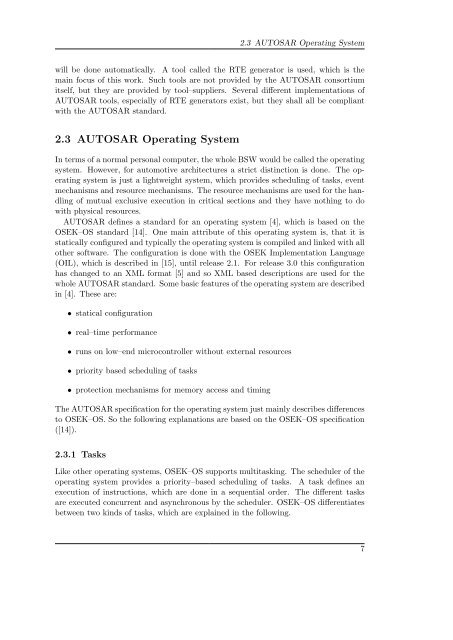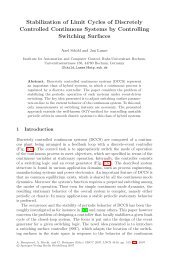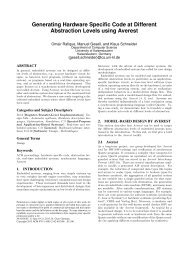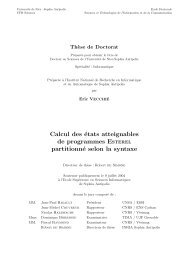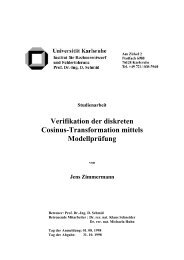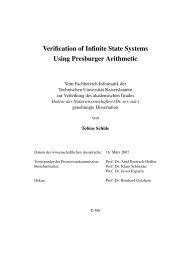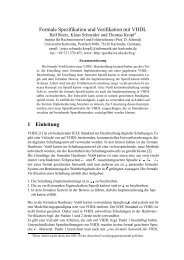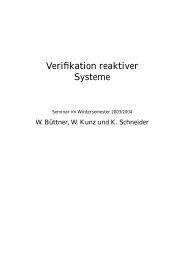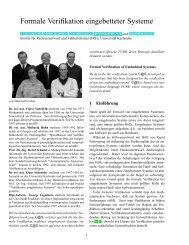Evaluation Environment for AUTOSAR-Autocode in Motor Control ...
Evaluation Environment for AUTOSAR-Autocode in Motor Control ...
Evaluation Environment for AUTOSAR-Autocode in Motor Control ...
Create successful ePaper yourself
Turn your PDF publications into a flip-book with our unique Google optimized e-Paper software.
2.3 <strong>AUTOSAR</strong> Operat<strong>in</strong>g System<br />
will be done automatically. A tool called the RTE generator is used, which is the<br />
ma<strong>in</strong> focus of this work. Such tools are not provided by the <strong>AUTOSAR</strong> consortium<br />
itself, but they are provided by tool–suppliers. Several different implementations of<br />
<strong>AUTOSAR</strong> tools, especially of RTE generators exist, but they shall all be compliant<br />
with the <strong>AUTOSAR</strong> standard.<br />
2.3 <strong>AUTOSAR</strong> Operat<strong>in</strong>g System<br />
In terms of a normal personal computer, the whole BSW would be called the operat<strong>in</strong>g<br />
system. However, <strong>for</strong> automotive architectures a strict dist<strong>in</strong>ction is done. The operat<strong>in</strong>g<br />
system is just a lightweight system, which provides schedul<strong>in</strong>g of tasks, event<br />
mechanisms and resource mechanisms. The resource mechanisms are used <strong>for</strong> the handl<strong>in</strong>g<br />
of mutual exclusive execution <strong>in</strong> critical sections and they have noth<strong>in</strong>g to do<br />
with physical resources.<br />
<strong>AUTOSAR</strong> def<strong>in</strong>es a standard <strong>for</strong> an operat<strong>in</strong>g system [4], which is based on the<br />
OSEK–OS standard [14]. One ma<strong>in</strong> attribute of this operat<strong>in</strong>g system is, that it is<br />
statically configured and typically the operat<strong>in</strong>g system is compiled and l<strong>in</strong>ked with all<br />
other software. The configuration is done with the OSEK Implementation Language<br />
(OIL), which is described <strong>in</strong> [15], until release 2.1. For release 3.0 this configuration<br />
has changed to an XML <strong>for</strong>mat [5] and so XML based descriptions are used <strong>for</strong> the<br />
whole <strong>AUTOSAR</strong> standard. Some basic features of the operat<strong>in</strong>g system are described<br />
<strong>in</strong> [4]. These are:<br />
• statical configuration<br />
• real–time per<strong>for</strong>mance<br />
• runs on low–end microcontroller without external resources<br />
• priority based schedul<strong>in</strong>g of tasks<br />
• protection mechanisms <strong>for</strong> memory access and tim<strong>in</strong>g<br />
The <strong>AUTOSAR</strong> specification <strong>for</strong> the operat<strong>in</strong>g system just ma<strong>in</strong>ly describes differences<br />
to OSEK–OS. So the follow<strong>in</strong>g explanations are based on the OSEK–OS specification<br />
([14]).<br />
2.3.1 Tasks<br />
Like other operat<strong>in</strong>g systems, OSEK–OS supports multitask<strong>in</strong>g. The scheduler of the<br />
operat<strong>in</strong>g system provides a priority–based schedul<strong>in</strong>g of tasks. A task def<strong>in</strong>es an<br />
execution of <strong>in</strong>structions, which are done <strong>in</strong> a sequential order. The different tasks<br />
are executed concurrent and asynchronous by the scheduler. OSEK–OS differentiates<br />
between two k<strong>in</strong>ds of tasks, which are expla<strong>in</strong>ed <strong>in</strong> the follow<strong>in</strong>g.<br />
7


